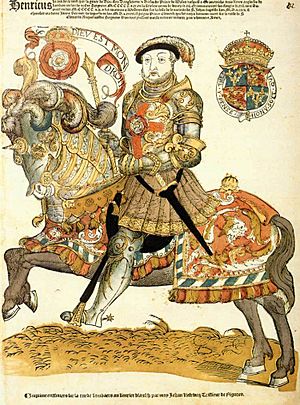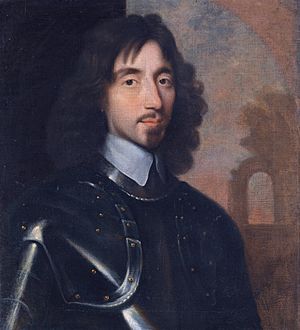English Army facts for kids
Quick facts for kids English Army |
|
|---|---|
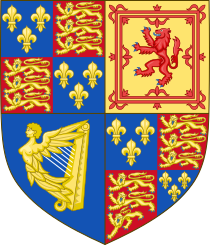
|
|
| Active | 1660–1707 |
| Country | |
| Allegiance | English monarchy |
| Type | Army |
| Engagements | |
| Commanders | |
| Captain-General | George Monck, John Churchill |
| Notable commanders |
Prince Rupert, James Scott, James Butler, Henri de Massue, James Stanhope |
The English Army was the official army of England when it was an independent country. For a long time, England didn't have a permanent army. Instead, soldiers were gathered only when needed for a war.
This changed during a period called the Interregnum (1649–1660). A special army, the New Model Army, was created by Parliament during the English Civil War. This was the first time England had a professional, full-time army even during peacetime.
When the king returned to power in 1660, Charles II decided to keep a small standing army. This new army was formed from parts of the old Royalist army and even some soldiers from the New Model Army. Many of the famous regiments in today's British Army can trace their history back to these early English Army units. Even the Royal Marines started from a special "maritime regiment" of the English Army in 1664.
Contents
How England's Army Began
Long before the English Army, there were early attempts to organize fighting forces. In the Middle Ages, around 1252, King Henry III made a rule called the Assize of Arms. This rule said that people who owned land had to own weapons and train with them.
For example, smaller landowners had to have a bow and be trained to use it. Wealthier people needed a sword, dagger, and a longbow. This helped create a group of trained fighters ready to defend the country if needed.
Tudor and Stuart Armies
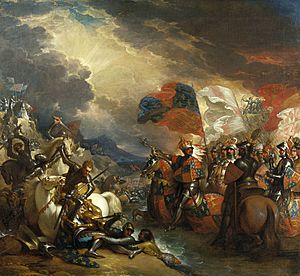
Before the English Civil War in 1642, English kings like Henry VII and Henry VIII had small personal guards. These were groups like the Yeomen of the Guard and the Honourable Corps of Gentlemen at Arms. They also had a few local groups of soldiers to protect important places like ports.
When England needed to fight a war abroad, the king would gather troops just for that war. This was based on an old system where powerful lords had to provide a certain number of knights and soldiers in exchange for their land.
Kings would ask noblemen or experienced soldiers to gather troops for them. They used special orders to raise soldiers for foreign wars. There were also laws that said all men who owned a certain amount of property had to keep weapons at home and practice using them. However, these training sessions were often messy and not very serious.
The English Civil War
In 1642, the English Civil War began between the King's supporters (Royalists) and Parliament's supporters (Roundheads). Both sides quickly gathered soldiers wherever they could. They both claimed they had the legal right to do so.
After two years of fighting, Parliament decided to create a new, professional army. This was the New Model Army, the first standing army in modern English history. A skilled soldier named Sir Thomas Fairfax was put in charge.
The New Model Army was very successful in battle. As Sir Winston Churchill famously said about the Second English Civil War: "The Army beat the lot!" This meant the army defeated everyone who opposed it, including the King, Parliament, and even the Scottish army.
The New Model Army became very powerful. Its leaders, known as the "Grandees," sometimes disagreed with Parliament. After the Second English Civil War, the army became even more dominant. Soldiers even used force to stop members of Parliament who disagreed with them from attending meetings. This led to King Charles I being put on trial and executed, and England becoming a Commonwealth (a republic).
Over the next two years, the New Model Army invaded Ireland and Scotland. They defeated their armies and took control of their lands. The Civil War finally ended in 1651 when the New Model Army easily defeated a Scottish Royalist army led by Charles II at the Battle of Worcester.
England Without a King
During the Interregnum (1649–1660), England was ruled without a king. The power of the government depended entirely on the strength of the New Model Army. The army was always able to handle any challenges, whether from inside England or from other countries.
Two important things happened during this time. First, the army took complete control when Oliver Cromwell dissolved Parliament in 1653. This was the closest England has ever come to a military takeover. Second, at the Battle of the Dunes (1658), New Model Army soldiers, wearing their famous red coats, amazed everyone with their fierce attack on a strongly defended sand-hill.
After Oliver Cromwell died, the army leaders couldn't agree on who should rule. So, they decided to bring back King Charles II. General George Monck of the New Model Army played a key role in making this happen peacefully in 1660.
Many experts believe that the New Model Army, with its victories at battles like Naseby and Dunes, laid the groundwork for the professional British Army we know today.
The King Returns and the Army is Restored
On January 26, 1661, King Charles II officially created the first regiments of what would become the British Army. However, England and Scotland still had separate armies until they officially united in 1707. Ireland also had its own army.
During his time in exile, King Charles II had seen how the French King Louis XIV organized his permanent army. When Charles returned to England, he wanted to build a strong army to protect his newly restored throne.
This was a big change for England, as people were not used to having a permanent army. Charles II introduced it slowly. At first, his army was very small, with only about 5,000 men.
Charles put soldiers who had been loyal to him during his exile into these new regiments. He also included some soldiers from the New Model Army to keep the peace. The new army included two cavalry (horse) regiments and five or six infantry (foot) regiments. These included famous units like the Life Guards, the Blues, the Grenadier Guards, and the Coldstream Guards.
Many English people were worried about having a standing army. They remembered the time when the New Model Army had ruled the country and how expensive it was. They also remembered when King Charles I had ruled without Parliament for eleven years. They feared that a permanent army under the king's control would allow future monarchs to ignore Parliament's wishes.
King's Army or Parliament's Army?
Many English people didn't fully accept the need for a standing army until the time of King William III. By then, England was often at war with other European countries. A small standing army became necessary to defend England and keep its influence in the world.
However, the public still wanted to make sure the king couldn't use the army to take too much power. Parliament eventually gained control over the army. They passed a law called the Mutiny Act. This law made it so that the standing army could only exist if Parliament approved it every single year. This gave Parliament a lot of power over the army and protected the people's freedom.
Who Was in Charge?
The King or Queen was the supreme commander of the English Army. However, after 1660, monarchs usually didn't lead their forces in battle themselves. Instead, they would give command to a skilled soldier, especially during wartime. For example, King Charles II appointed General George Monck as "captain general" in 1660, giving him wide powers.
Over time, other important roles were created to help manage the army. These included the Paymaster General (who handled army pay), the Surgeon General (for medical care), and the Judge Advocate General (for legal matters). Later, roles like the Adjutant-General and Quartermaster-General were added.
By the early 1700s, a government official called the Secretary at War became very important. This person was in charge of raising the army, giving marching orders, and managing its money.
English Army in Action
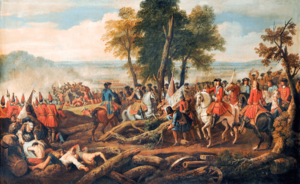
The English Army was involved in many conflicts during its existence:
- The Second Anglo-Dutch War (1665–1667) was mostly fought at sea. But English soldiers took part in attacks like Holmes's Bonfire and defended places like Landguard Fort.
- The Third Anglo-Dutch War (1672–1674) was also mainly a naval war. However, English soldiers, including the future Duke of Marlborough, fought alongside French forces in battles like the Siege of Maastricht (1673).
- In 1678, an English force was sent to Flanders to help the Dutch fight the French in the Franco-Dutch War. Some British units fought bravely at the Battle of Saint-Denis (1678).
- The English Army also fought in the Monmouth Rebellion and the Battle of Sedgemoor in 1685.
- They were involved in the Glorious Revolution (1689), the Williamite War in Ireland (1688–1691), and the Nine Years War (1688–1697).
- Finally, the English Army played a major role in the War of the Spanish Succession (1701–1714), a huge European conflict.
Joining the British Army
After the Act of Union in 1707, England and Scotland officially became one country: Great Britain. At this point, the English Army and the Scottish Army were combined to form the British Army.
The order of importance for regiments in the British Army is still based on how old they were in the English Army. Scottish and Irish regiments were given a rank based on when they first joined the English army. For example, a Scottish regiment called the Scots Greys was ranked as the 2nd Dragoons in the British Army because it had joined the English army in 1685, when there was only one English dragoon regiment.
See also
- Military of England
- Wars of Scottish Independence
- Hundred Years' War
- Anglo-Scottish Wars


